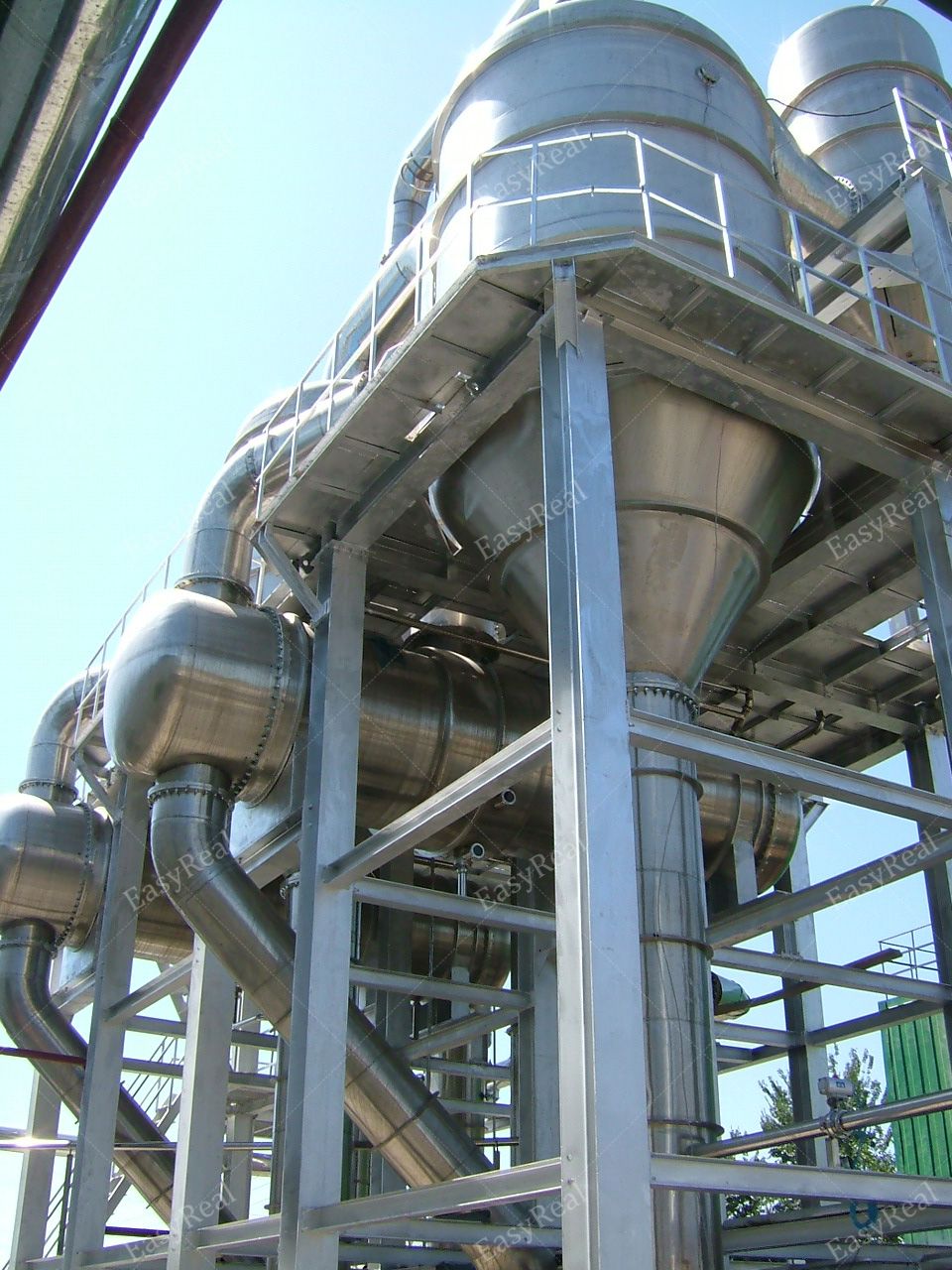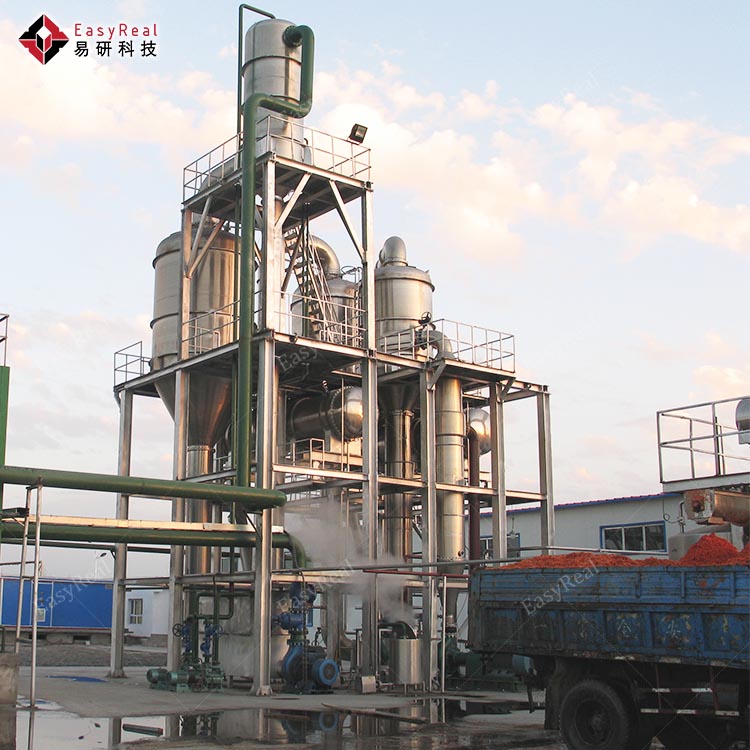Multi Effect Forced Circulation Evaporator
EasyReal engineers this system around simple thermal logic that teams can trust.
The loop drives high-velocity recirculation through a shell and tube heater, which heat-warms the product under pressure.
The stream then enters a vacuum separator and flashes.
Boiling happens in the vessel, not in the tubes, so the exchanger stays cleaner for longer.
The loop stabilizes U-values as viscosity climbs, which means you keep targets at high °Brix.
PLC-based closed-loop control manages setpoints for inlet temperature, steam valve position, flash pressure, and recycle flow.
HMI screens present real-time trends, alarms, and recipes, so one operator oversees the batch or shift with confidence.
Stainless steel contact surfaces, sanitary piping, and CIP layouts protect hygiene and shorten changeovers.
Skid modules keep the footprint tight and simplify service access.
Batch-to-batch repeatability improves scheduling, while energy reuse across multiple effects reduces operating cost.
Food processors run this multi-effect forced circulation evaporator on tomato, carrot, apple, apricot, and berry pastes when viscosity and suspended solids challenge thin falling-film designs.
Juice concentrate manufacturers use it to hit high Brix targets with steady color and aroma.
Manufacturers aseptically prefer stable heat transfer, predictable fouling behavior, and simple cleaning steps.
Teams that support audits keep records from the PLC, which reduces manual notes and speeds reviews.
Packaging lines benefit from uniform viscosity and tighter flow windows.
Customer service teams see fewer complaints because deliveries stay on spec, week after week.
Each of these outcomes builds trust with buyers and supports long-term contracts.
Raw fruits carry pulp, seeds, fibers, and pectin.
These components thicken under heat and can stick to hot surfaces.
The forced circulation evaporator handles this risk by moving liquid fast through the heater and shifting boiling into the separator.
Upstream, simple screens or finishers remove coarse particles that could plug valves.
Preheaters raise feed temperature and reduce thermal shock.
Optional deaeration trims air that would otherwise spoil color and aroma.
Hygienic piping, sloped drains, and defined CIP recipes protect food safety and keep the loop clean.
Operators check pump seals and gaskets before the shift to avoid leaks and downtime.
Teams document temperatures, pressures, and flows in the HMI trends, so supervisors can review proof when audits arrive.
This line design manages viscosity growth, protects quality, and supports predictable production windows.
Start with capacity math.
Multiply required evaporation rate by shifts and seasonal days to size the train.
Set target °Brix and pick the number of effects to meet steam goals.
Add TVR if you want more savings with a small footprint change.
Consider MVR where electricity pricing makes sense.
Size heat transfer area for the worst-case viscosity at your final solids.
Check flash pressures and temperature approach to keep aroma and color intact.
Use large-radius elbows and full-bore valves in the recycle loop to reduce shear and plugging.
Verify vacuum capacity and condenser duty in hot months when cooling water temperature rises.
Select stainless steel grades for contact parts and match seals to organic acids and sugars.
Finish with a pilot or scale-up run to confirm setpoints and residence time.
The right configuration holds targets, runs clean, and protects cost per kilo.
• Raw intake & screening. Receive paste or purée. Remove coarse seeds and fibers to protect valves and pumps.
• Preheating. Warm feed to the recommended inlet temperature to stabilize flash behavior.
• Effect 1 heating. Pump at high velocity through the shell and tube heater. Keep liquid under pressure so it does not boil in the tubes.
• Separator flash. Drop pressure into the vessel. Boil off water quickly. Remove vapor and collect concentrate.
• Downstream effects. Repeat heating and flash across effects to reuse energy and lower steam per kilogram of water evaporated.
• Condensation & vacuum. Condense vapor in the surface condenser and hold stable vacuum. Route condensate to recovery.
• Product cooling. If needed, cool concentrate to protect color and aroma before storage or packing.
• Branching for styles.
o Smooth purée: run a standard loop and finish to target °Brix.
o With pieces or fibers: keep velocities high; widen strainers; adjust valves to protect inclusions.
o High Brix, low sugar styles: tighten temperature approach and watch residence time to protect flavor.
1) Shell and Tube Heater (Pressurized Heating)
• The heater adds energy while the liquid stays under pressure, so tubes do not see boiling.
• This approach reduces fouling on hot surfaces and holds heat transfer steady across the run.
• Operators set steam valve positions and monitor inlet and outlet temperatures on HMI screens.
• The design allows tight ∆T control, which protects color and sensitive aroma compounds.
• Larger diameter tubes and smooth inlets support higher recycle flow with less shear.
• EasyReal sizes surface area to match worst case viscosity, so the line keeps targets at high °Brix.
2) High Velocity Recirculation Loop
• A dedicated pump drives fast flow through the heater and back to the separator.
• High velocity adds a “self-cleaning” effect that slows deposit build-up.
• Full bore valves and large radius elbows lower pressure drop and protect fibers or soft pieces.
• Sight glasses and pressure transmitters help operators confirm stable loop behavior.
• The loop resists surges when feed solids drift during the season.
• Teams tune recycle ratios to keep residence time short while pushing final solids higher.
3) Flash / Separator Vessel
• The vessel receives hot liquid from the heater and instantly flashes water under vacuum.
• Boiling happens here, away from the tubes, which keeps the exchanger cleaner.
• Internal geometry supports quick vapor disengagement and smooth liquid outflow.
• Level instruments and anti-foam controls protect stability at high throughput.
• Drainable bottoms, spray balls, and defined CIP steps make cleaning repeatable.
• Operators watch flash pressure and product temperature to protect aroma and color.
4) Condenser and Vacuum System
• The surface condenser turns vapor into condensate and stabilizes vacuum across effects.
• Cooling water or glycol circuits remove heat without spiking product temperature.
• The vacuum environment skid handles non-condensables to keep flash temperatures predictable.
• Instruments log pressure, temperature, and flow for audits and troubleshooting.
• Condensate and vent routing follow hygienic practices to protect the space.
• Right-sized duty keeps the plant running even during hot weather or peak loads.
5) Multi-Effect Train with TVR / MVR Options
• Effects connect in series so vapor from one effect heats the next.
• TVR adds motive steam to recompress vapor and cut new steam demand.
• MVR uses a mechanical compressor to lift vapor energy when electricity suits the case.
• Proper piping and controls avoid flooding and protect energy savings.
• Plants upgrade in stages as volumes grow or utility tariffs change.
• Clear HMI trends help teams measure savings and prove the business case.
Fruit processors face swings in crop quality and cost.
The line accepts fresh purée, frozen blocks, aseptic feed, and/or concentrate blends.
Operators adjust recipes for solids, acidity, and fiber load.
Settings change fast between product families to keep downtime low.
Teams build a finished product matrix that covers standard high-Brix pastes and specialty items that need different viscosity or color targets.
When buyers request private-label variants, the system handles small batches without long cleaning time.
Pumps and valves suit a wide range of thickness, so you can run light purées in the morning and thicker pastes later.
These configuration options protect capacity through the season and reduce risk when the market shifts.
PLC recipes define temperatures, pressures, and recycle flows. Interlocks protect equipment when feeds surge or when utilities drift. Operators read HMI trends and alarms to spot issues early. Engineers export batch or shift reports for audits. Role based access controls separate supervisor changes from operator tasks. Remote support helps teams diagnose problems and shorten downtime. Spares and maintenance plans keep critical parts on the shelf. This control approach removes guesswork from daily runs, which raises yield and lowers steam use. The software also standardizes changeovers, so you switch products with less stress.
We guide you from scope to first season. Start with duty, final °Brix, and weekly volumes. Share utility limits for steam, power, cooling water, and drains. We run heat and mass balances, propose effect counts, and flag TVR or MVR options when they fit. You review a layout and P&ID, then confirm setpoints in a pilot or site trial. We commission the train, train operators, and set up CIP procedures. We support your team through the first peak with remote help and spare parts. Request a proposal and energy estimate today. You get a clear path to stable quality, fewer cleanings, and a lower cost per kilo.












